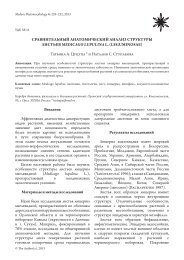Introduction Lichens are long living organisms with a high sensibility ...
Introduction Lichens are long living organisms with a high sensibility ...
Introduction Lichens are long living organisms with a high sensibility ...
Create successful ePaper yourself
Turn your PDF publications into a flip-book with our unique Google optimized e-Paper software.
Modern Phytomorphology 4: 115–116, 2013Morphological changes and damages ofindicator lichens from Sakhalin IslandAlexander K. EzhkinAbstract. Lichen morphological changes, abnormalities and damages <strong>are</strong> very important parameters that define thegeneral vitality of lichen communities. Correct detecting of lichen abnormalities helps to make an accurate assessment ofthe disturbance level of ecosystems. Main morphological changes and damages of indicator lichens of the Sakhalin Island<strong>are</strong> discussed.Key words: lichens, morphological changes, damages, necrosis, biomonitoring, bioindication, SakhalinInstitute of Marine Geology and Geophysics FEB RAS, 1B Nauki str., Yuzhno-Sakhalinsk, 693000, Russia; Ezhkin@yandex.ru© The Author(s), 2013<strong>Introduction</strong><strong>Lichens</strong> <strong>are</strong> <strong>long</strong> <strong>living</strong> <strong>organisms</strong> <strong>with</strong> a <strong>high</strong><strong>sensibility</strong> to environmental impacts. The <strong>high</strong>sensitivity of lichens is related to lichens biology.The using of lichens as air quality detectors isa well-documented procedure (Skye 1979;Richardson & Nieboer 1981). The mostcommon approach involves a floristic surveyand elemental analysis of tissues from selectedindicator species (St. Clair 1989; Wetmore1989). Lichen physiological processes indicatepollution related to the damage significantlyearlier than other <strong>with</strong> more visible changesin color, morphology or community structurewhich can be detected and monitored (Fields& St. Clair 1984). Lichen tissue damagesoccur after <strong>long</strong>-term or repeated influence of<strong>high</strong> concentrations of various pollutants inthe air which <strong>are</strong> associated <strong>with</strong> stationary andmobile sources of the pollution. Damages andchanges in lichen morphology <strong>are</strong> detected andmeasured by transplants and other methods ofbioindication (Brodo 1961). Abnormalitieswhich occur due to air pollution <strong>are</strong> not thesame for all lichen species. Therefore it is veryimportant to know and recognize them whenusing lichens as bio-monitors.Material and methods<strong>Lichens</strong> were collected from all availablesubstrates (rock, concrete, soil, tree bark andbranches, dead wood, moss) and varied habitats(urban <strong>are</strong>as, conifer and deciduous forests, seashores and mountains) on different distancesfrom potential pollution sources – <strong>high</strong>ways,heat power plants, boiler houses and LNG plant.The investigations were performed in Korsakov,Aniva, Dolinsk and Nogliki districts of theSakhalin Island. Lichen species were identifiedusing standard lichen keys and taxonomictreatises. Damages and morphological changeswere studied visually using hand magnifier andmicroscope.Results and discussionColor changesThe most frequently occurred damage onlichens due to air pollution is bleaching orreddening of the upper cortex of foliose, crustoseand fruticose lichens. Color change is a formof necrosis and it happens when algae layer isdestroyed. Sensitive and intermediate sensitivelichens <strong>are</strong> exposed to this damage more oftenthan tolerant species. Bleaching and reddeningoften happen <strong>with</strong> many lichens from nextgenera: Flavoparmelia, Flavopunctelia, Parmelia,Hypogymnia, Heterodermia, Lobaria, Lecanora,Pyrenula, Graphis, Buellia, Peltigera, Nephroma,Melanelia, Menegazzia, Cetraria, Cladonia,Myelochroa, Parmeliopsis, Phaeophyscia, Physcia,Physconia, Platismatia etc. Dark brown or black
116 Modern Phytomorphology 4 (2013)colored “burns” often occur on tips of the lobesand the branches of some sensitive lichen genera– Lobaria, Bryoria, Usnea. The color of thallussurface is always more pale in polluted <strong>are</strong>asprobably due to reduction in photosyntheticcapacity (Fields & St. Clair 1984). It happens<strong>with</strong> many lichens including tolerant species– Phaeophyscia hirtuosa, Ph. rubropulchra,Physciella chloantha, Physcia stellaris.Destruction of upper cortexThis damage usually follows after colorchange and it often occurs <strong>with</strong> sensitive andintermediate sensitive lichens. Lobaria losetheir upper cortex in disturbed habitats morefrequently and faster than other lichens. Thisdamage usually causes death of lichen in verysoon. It also happens <strong>with</strong> tolerant lichens whenpollution level changes very fast.Reproductive system abnormalitiesReproductive organs <strong>are</strong> very sensitive to airpollution. Absence of the apothecia often occurs<strong>with</strong> sensitive lichens – Lobaria pulmonaria,L. quercizans, Peltigera collina as well as tolerantlichens – Myelochroa subaurulenta, Parmeliafertilis, Lecanora pachyheila, Melanelia olivacea.Destruction of apothecia and perithecia isusual for crustose lichens – Lecanora allophana,L. chlarotera, Brigantiaea nipponica, Graphisscripta, Pyrenula japonica in polluted <strong>are</strong>as.Lichen apothecia and perithecia of crustoselichens become empty or look deformed inpolluted <strong>are</strong>as. Hyperproduction of sorediaeand isidiae can be often found in sensitiveand intermediate sensitive species – Lobariapulmonaria, L. spathulata, Parmelia squarrosaas well as in tolerant species – Phaeophysciahispidula, Physconia grumosa, Parmelia sulcata,Physciella melanchra, Flavopunctelia soredicawhich occur in polluted <strong>are</strong>as. Sometimessolid mass of soredia or isidia may cover all thesurface of the upper cortex, but it can be normalfor lichens found in clear <strong>are</strong>as because of theold age of the lichen.Colonization by other lichensThis abnormality usually happens <strong>with</strong>sensitive lichens – Lobaria pulmonary, Leptogiumburnetiae and some other lichens from these twogenera in polluted <strong>are</strong>as. In disturbed <strong>are</strong>as thethallus of the sensitive lichen is often colonizedby aggressive lichens from tolerant groups likePhaeophyscia hirtuosa, Physciella chloantha,Candelaria concolor etc.Dwarf growth and deformationsThese abnormalities <strong>are</strong> very common foralmost lichens in polluted <strong>are</strong>as. Its occur bothin sensitive and tolerant species. Lichen thallusbecome compact, deformed, torose and thick.The lichen thallus often looks like a small shrub.Additional lobes formationIn polluted <strong>are</strong>as lichens often form smallrudimentary lobes a<strong>long</strong> the main lobe edge.It frequently happens <strong>with</strong> sensitive andintermediate sensitive lichens like Lobariapulmonaria and L. spathulata etc.Sparse and short rhizinesThis abnormality is very common for lichensin urban <strong>are</strong>as and it often follows <strong>with</strong> sparseand short hairs around the apothecia of somePhaeophyscia species like Ph. hirtuosa and other.ReferencesBrodo I.M. 1961. Transplant experiments <strong>with</strong>corticolos lichens using a new technique. Ecology 42(4): 838–841.Fields R.D., St. Clair L.L. 1984. The effects of SO 2onphotosynthesis and carbohydrate transfer in the twolichens: Collema polycarpon, Parmelia chlorocroa. Am. J.Bot. 71: 986–998.Richardson D.H.S., E. Nieboer. 1981. <strong>Lichens</strong> andpollution monitoring. Endeavour, New Series 5 (3):127–133.Skye E. 1979. <strong>Lichens</strong> as biological indicators of airpollution. Ann. Rev. Phytopathol. 17: 325–341.St. Clair L.L. 1989. Development of an air qualitybiomonitoring program, using lichens, for the JarbidgeWilderness Area, Humboldt National Forest, Nevada.U.S. Forest Service. Technical Report.Wetmore C.M. 1989. <strong>Lichens</strong> and air quality inCuyahoga Valley National Recreation Area, Ohio.Bryologist 92: 273–281.








